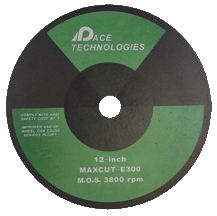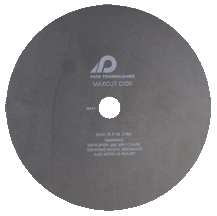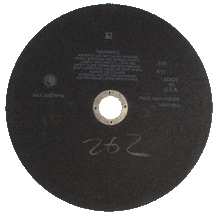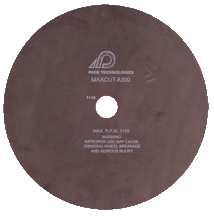Abrasive Sectioning Consumables
Our abrasive sectioning consumables deliver precise, efficient cuts for metallographic sample preparation. Choose from high-performance abrasive and diamond blades, plus cutting fluids ideal for metals, ceramics, and composites. Engineered to minimize deformation, our products ensure clean results for microstructural analysis.









Explore our advanced abrasive sectioning equipment, designed for precision and efficiency.
Key Tips for Abrasive Sectioning
- Choose the Right Blade: Match the blade to material type and hardness for clean cuts and reduced wear.
- Maintain Coolant Flow: Ensure proper coolant flow to minimize heat and prevent damage.
- Adjust Cutting Speed: Set appropriate speeds—slower for softer materials, faster for harder ones.
- Secure the Specimen: Clamp the specimen firmly to prevent movement and uneven cuts.
More Resources:
Introduction:
The first step in preparing a specimen for metallographic or microstructural analysis is to locate the area of interest. Sectioning or cutting is the most common technique for obtaining this area. Proper sectioning has the following characteristics:
Desirable Effects:
- Flat and cut close to the area of interest
- Minimal microstructural damage
Undesirable Effects:
- Smeared (plastically deformed) metal
- Heat affected zones (burning during cutting)
- Excessive subsurface damage (cracking in ceramics)
- Damage to secondary phases (e.g., graphite flakes, nodules, or grain pull-out)
Abrasive Blade Product Descriptions
Abrasive Blades (32 mm / 1.25-inch arbor) (Qty 10 per package)
| Description | 10-inch | 12-inch | 14-inch | 16-inch |
|---|---|---|---|---|
| Soft non-ferrous materials (aluminum, brass, zinc, etc.) | MAX-E250 | MAX-E300 | MAX-E350 | MAX-E400 |
| Hard non-ferrous materials (titanium, zirconium, etc.) | MAX-C250 | MAX-C300 | MAX-C350 | MAX-C400 |
| Soft steels | MAX-E250 | MAX-E300 | MAX-E350 | MAX-E400 |
| Hard and case-hardened steels | MAX-VHS250 | MAX-VHS300 | MAX-VHS350 | MAX-VHS400 |
| General steels and ferrous metals | MAX-D250T | MAX-D300 | MAX-D350 | MAX-D400 |
| Universal Thin Blade | MAX-A250 | MAX-A300 | MAX-A350 | MAX-A400 |
| Industrial general purpose thin blade | MAX-I250 | MAX-I300 | MAX-I350 | MAX-I400 |
Abrasive Cutting Fluid
Abrasive Blade Selection Guidelines
Selecting the right abrasive blade depends on the cut-off machine design and operator preference. Blades are characterized by abrasive type, bond type, and hardness, with the choice largely based on material hardness and whether it's ferrous or nonferrous. Resin/rubber blades emit more odor due to slight burning during cutting but have a longer lifespan. Resin blades, though more versatile and odor-free, wear down faster but offer a cleaner cut as the abrasive is continually renewed.
Historically, resin/rubber blades were more specialized, requiring extensive testing to match blade properties with machine parameters. These blades were popular in the US, but improved resins have shifted preference towards resin-bonded blades. Resin-bonded blades have long been favored in European and Asian markets.
Abrasive Blade Thickness
| Blade Thickness (inches) | 10-inch | 12-inch | 14-inch | 16-inch |
|---|---|---|---|---|
| MAX-A | 0.039 | 0.055 | 0.063 | 0.090 |
| MAX-C | 0.059 | 0.078 | 0.078 | 0.100 |
| MAX-D | 0.059 | 0.078 | 0.078 | 0.100 |
| MAX-E | 0.059 | 0.078 | 0.078 | 0.100 |
| MAX-I | 0.059 | 0.078 | 0.078 | 0.100 |
| MAX-VHS | 0.075 | 0.078 | 0.098 | 0.100 |
| DMAX | 0.059 | 0.060 | 0.060 | 0.075 |
Abrasive Blade Maximum Operating Speed (MOS)
| Maximum Speed (rpm) | 10-inch | 12-inch | 14-inch | 16-inch |
|---|---|---|---|---|
| MAX-A | 3820 | 3185 | 2730 | 2860 |
| MAX-C | 3440 | 3185 | 3460 | 2390 |
| MAX-D | 4585 | 3820 | 3275 | 3800 |
| MAX-E | 4500 | 3800 | 3200 | 3800 |
| MAX-I | 4500 | 3800 | 3200 | 3800 |
| MAX-VHS | 3055 | 2500 | 2220 | 1925 |
| DMAX | 6100 | 5000 | 4350 | 3800 |
Abrasive Cutting Process
Abrasive sectioning is ideal for cutting ductile materials like metals, composites, plastics, and rubbers. Selecting the right abrasive blade involves understanding the relationship between the abrasive type, bonding, and specimen properties.
Abrasive Types
Modern blades use alumina or silicon carbide abrasives. Alumina, tough and moderately hard, is best for ferrous metals. Silicon carbide, harder and self-sharpening, is ideal for nonferrous metals.
Bonding Materials
The bonding material should break down at the same rate as the abrasive dulls, optimizing efficiency. The right resin system depends on the sample's hardness and wear characteristics.
Abrasive Cutter Speed
Variable speed saws enhance control by matching cutting speed to material hardness. Softer metals require slower speeds to minimize burrs, while harder materials benefit from higher speeds to expose sharp abrasives. For hardened steels, use 50% of the blade’s maximum speed to avoid overheating.
Recommended Abrasive Cutting Procedures
- Choose the correct abrasive blade for the material.
- Secure the specimen properly to prevent damage.
- Maintain coolant levels and replace when dirty to manage debris from blade wear.
- Adjust cutter speed based on material hardness—slower for softer metals, faster for harder samples.
- Ensure the blade reaches full speed before cutting.
- Use steady force or light pulsing to optimize cuts and preserve sample integrity.
- When cutting coated materials, position the specimen to cut into the coating and exit through the base material to keep the coating in compression.
Cutting Fluids
- Choose the correct abrasive blade for the material.
- Secure the specimen properly to prevent damage.
- Maintain coolant levels and replace when dirty to manage debris from blade wear.
- Adjust cutter speed based on material hardness—slower for softer metals, faster for harder samples.
- Ensure the blade reaches full speed before cutting.
- Use steady force or light pulsing to optimize cuts and preserve sample integrity.
- When cutting coated materials, position the specimen to cut into the coating and exit through the base material to keep the coating in compression.
Lubrication and swarf removal during abrasive cutting and diamond wafer cutting are required in order to minimize damage to the specimen. For some older abrasive cutters, the proper cutting fluid can also have the added benefit of coating cast iron bases and the fixtures in order to reduce or eliminate corrosion.
TIP: Most abrasive cutters have a hood, which can produce a corrosive humidity chamber when not in use. In order to reduce these corrosive effects, keep the hood open when not in use.
Abrasive Cutting Fluid - The ideal cutting fluid for abrasive cutting is one that removes the cutting swarf and degraded abrasive blade material. It should have a relatively high flash point because of the sparks produced during abrasive sectioning.
Abrasive Sectioning Troubleshooting
| Symptom | Cause | Action |
|---|---|---|
| Chipped or broken blade | Secure sample properly Reduce cutting force | Secure sample properly Reduce cutting force |
| Bluish burnt color on specimen | Incorrect cutting fluid Improper blade or excessive force | Use proper cutting fluid Consult applications guideline or use a blade with a softer resin |





